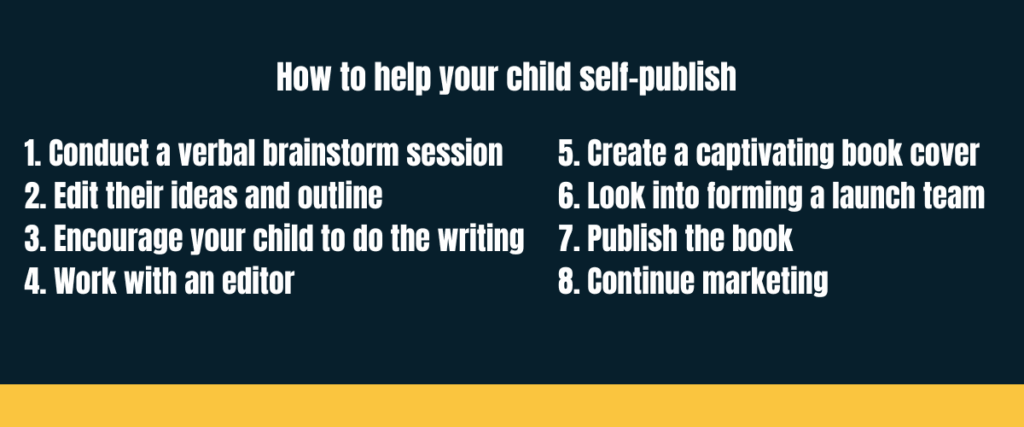Child self-publishing is a definite part of the publishing world, and one in which you can play a large role in helping your child succeed. Children have such vivid imaginations that they make fantastic authors. The big roadblock for children is that while they have extremely original imaginations, they do need help with the publishing process.
This is where your role as a parent or guardian can make all the difference. If you want to help your child self-publish but are unsure where to start, we cover everything in this post!
Help your child self-publish: what you learn
- Can a kid write a book and get it published?
- How to publish a book written by a child on Amazon
- How to best help your child self-publish


Book Outline Generator
Choose your Fiction or Nonfiction book type below to get your free chapter by chapter outline!
Book Outline Generator
Enter your details below and get your pre-formatted outline in your inbox and start writing today!
CONGRATULATIONS
Thanks for submitting! Check your email for your book outline template.
In the meantime, check out our Book Outline Challenge.

Can a kid write a book and get it published?
Kids can certainly publish books, as one of our youngest authors, Emma Sumners (just eight-years old!) shows. She not only wrote and published her book, but landed interviews with local media. Children make tremendous authors because of their young, creative minds, and innate passion for whatever they put their mind to.
If you are a parent of young children or have interacted with children for even a few minutes, you know how dedicated they are to the projects they undertake. Whether building a fort in the living room or turning that one white wall into a canvas (a parent’s nightmare!), children love creating.
Sometimes it can be hard to encourage them to put down their creativity and come eat lunch. For child self-publishing, this determination is one you can channel, teaching your child to finish what they start.
But as a parent, how do you channel your child’s natural creativity into plot structure, a theme that will resonate with audiences, and character development that will carry an entire story?
How to publish a book written by a child on Amazon
How you help your child self-publish a book will vary based on their age, interests, and the story they want to tell. An eight-year-old wanting to tell a fairy story will need a bit of a different path than a twelve-year-old wanting to write a story about a recent vacation they took with the family. Regardless, below is an eight-step process to help you help your child self-publish.

1. Conduct a verbal brainstorm session
Many children process verbally. One of a child’s favorite words is simply, why? To help a child self-publish, conduct a brainstorm session with them and use their own favorite word to help them out. Ask them questions, ask them why, and jot down what they tell you. If they are old enough, allow them to do the writing.
Remember that brainstorming, whether for a child to self-publish or for an adult, is a time when there are no bad ideas. You can scratch out ideas later, but for now, any idea goes. Lead by example during this first stage of the publishing process. Give your own ideas, whether you think they are good or bad, to encourage your child to do the same.
You can use sticky notes to jot down ideas, notebook paper, colored construction paper, or anything else that intrigues your child. The important part of this process is to simply help your child get their ideas down.
2. Edit their ideas and outline
After you brainstorm, it’s time to walk your child through the process of editing the ideas down into the one key idea. As you cut out ideas, a key theme or plot will emerge. At this point, you can simply arrange your sticky notes (or whatever you used to track ideas) into a rough book outline. From here, you will move on to the actual writing process.
Before we get ahead of ourselves, try asking your child the following questions. These questions are geared to help your child forgo ideas they are not as interested and keep the ones they love.
- What idea do you like most?
- Which idea do you not like very much?
- Do any of these ideas seem to go together?
Do your best to allow them the autonomy to make the choices without prodding. The joy of helping a child self-publish is watching them discover their own creative capacities and come up with a novel idea with as little help as possible. Once you have a rough outline of ideas from your brainstorm session, move on to step three.
3. Encourage your child to do the writing
Now it’s time to turn the edited ideas into a book. If your child is old enough, equip them with a pen and notebook and encourage them to write for a set period of time.
It’s important to note that a child’s best work will vary greatly from child to child. While professional novelists can write upwards of 2500 words per day, a child, especially a child who is easily distracted, may struggle to put three sentences together.
The important aspect to focus on is the writing itself, rather than how much writing they do. Some children’s books may have just one sentence per illustrated page, while a children’s chapter book could stretch between 1000-10000 words.
To help your child self-publish, encourage them through the writing process, which is often the most daunting part of publishing. You may want to set up milestone markers, complete with small celebrations, throughout the writing process. For example, if they write every day for five days straight, set up a play date with their friend or take them to ice cream.
4. Work with an editor
Once your child has drafted their book, whether one-hundred words or one-thousand, it’s time to hire a professional editor. Believe it or not, even children’s books benefit from a professional edit! Find out how to hire a book editor here.
5. Create a captivating book cover
While we’ve all been told not to judge a book by its cover, the fact remains that many of us do. The same applies to your target audience. If they don’t like what they see, chances are slim they will pick it up off the shelf or add it to their Amazon cart.
Because of this, when helping your child self-publish, it’s crucial to design a book cover that will grab potential readers. You can find a template on Canva and create changes that better reflect your child’s book, or you can work with a book cover designer to ensure your cover is as professional as possible.
Let your child take the lead in creative decisions, but at the same time, communicate the importance of listening to their book designer’s opinion. This is a difficult line for adults to balance, and leading your child through the process early on will help them with their future book endeavors.
6. Look into forming a launch team
You have now walked your child through brainstorming, writing, editing, and designing a cover. To successfully help your child self-publish, you will want to look into building a launch team.
A book launch team can help you with book marketing, because launch team members:
- Read the book prior to its release day
- Share about the book on social media
- Leave reviews
Their efforts help generate buzz and ideally, help your book achieve a successful launch day. Creating a launch team is a great way to involve your child’s friends and parents in the publishing process as well.
7. Publish the book
It’s time to help your child self-publish their book! You can now walk them through uploading their book to Amazon KDP. After this process, they will officially be a child self–published author. Self-publishing a book is a huge accomplishment and to achieve this as a child is an even bigger feat. Well done, parents, for helping make it happen!
8. Continue marketing
Don’t forget that continued sales often rely on continued marketing efforts. Just because your child self-published does not mean you should stop marketing. Keep at it!
Marketing for homeschooling parents

For homeschooling parents, you may want to consider tying lessons on marketing into your curriculum. Teaching your student how to continue marketing their book will enable them to learn invaluable life skills they can apply to their next book, if they choose to publish again.
How to best help your child self-publish
There are so many amazing self-publishing success stories out there, and your child could be one of them. However, to give your child the best chance possible at succeeding, you may want to try the process yourself first.
Just as parents lead the way in showing children how to jump into the pool or make those cookies, you can lead the way in self-publishing as well. Self-publishing your own book first will not only pique your child’s interest in the process, but give you hands-on experience.
When you choose to self-publish your own book first, you get to see how the process works. As a result, you are better able to help your child through the self-publishing process. You can book a free call with one of our team members to discuss the publishing process that’s best for you.
Child self-publishing: take the first step today
You now know how to help your child self-publish their book. It’s time to take that first step and embark on the publishing process. Use our free Book Outline Generator to help you and your child start the publishing journey off strong!


Book Outline Generator
Choose your Fiction or Nonfiction book type below to get your free chapter by chapter outline!
Book Outline Generator
Enter your details below and get your pre-formatted outline in your inbox and start writing today!
CONGRATULATIONS
Thanks for submitting! Check your email for your book outline template.
In the meantime, check out our Book Outline Challenge.
